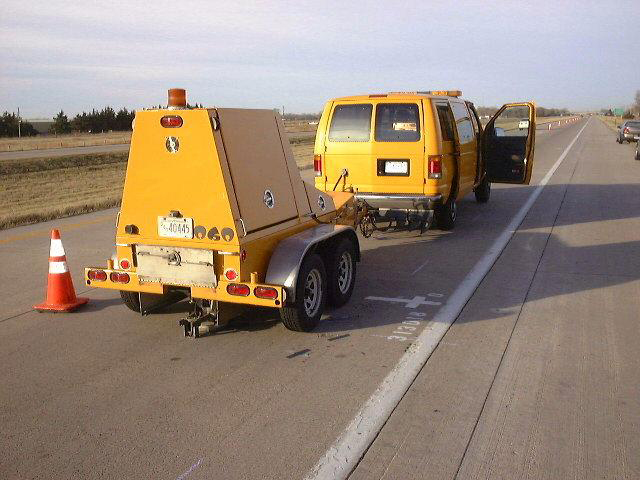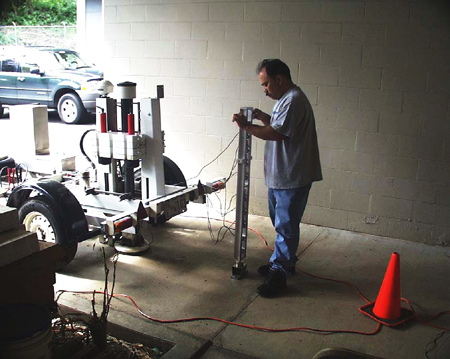U.S. Department of Transportation
Federal Highway Administration
1200 New Jersey Avenue, SE
Washington, DC 20590
202-366-4000
Focus
| Accelerating Infrastructure Innovations |
Publication Number: FHWA-HRT-10-008
Date: November 2009
First developed in the early 1990s for the Strategic Highway Research Program's (SHRP) Long Term Pavement Performance (LTPP) program, the Falling Weight Deflectometer (FWD) calibration system provides a method to assure that deflection data collected to assess the structural condition of pavements will be accurate and consistent. After the Federal Highway Administration (FHWA) assumed responsibility for managing the LTPP program in 1992, the four FWD calibration centers that had been established under SHRP in Pennsylvania, Texas, Nevada, and Minnesota continued to provide calibration services to the LTPP program, State transportation agencies, and others. In 2003, the Western Region calibration center moved from Reno, Nevada, to Denver, Colorado, where it is operated by the Colorado Department of Transportation. Now, improvements to the FWD calibration procedures, new calibration centers, and the forthcoming transitioning of FWD calibration center support services from the LTPP program to the American Association of State Highway and Transportation Officials (AASHTO) Materials Reference Laboratory will make FWD calibration services even more widely available and useful to the transportation community nationwide.
A nondestructive testing device, the FWD imparts a dynamic load to the pavement surface that is similar to that of a single heavy moving wheel load. The resulting pavement deflection can then be measured. This deflection data combined with the pavement layer thickness can be used to determine the in-situ resilient modulus of layers within a pavement structure and analyze the remaining service life of a pavement.
 |
An LTPP Falling Weight Deflectometer (FWD) in operation. |
 |
Onsite FWD calibration is performed in Hawaii. |
"The FWD calibration centers have been widely used by both public and private agencies for FWD calibration, providing a service that gives FWD owners and operators the best possible assurance of data quality," says Jane Jiang of FHWA. The LTPP program has supported the calibration centers by providing technical assistance, equipment replacement, quality assurance (QA) reviews, certification, and funding for an annual FWD Calibration Center Operator Meeting.
In 2004, FHWA initiated the Falling Weight Deflectometer Calibration Center and Operational Improvements Pooled Fund Study (No. TPF-5(039)) to update the FWD calibration system, expedite the calibration procedure, and identify a means of long-term support for the FWD calibration centers. Cornell University, developer of the original SHRP calibration system, was awarded a contract to perform the work. Eric Weaver of FHWA managed the study during its first 3 years, while Jane Jiang of FHWA has managed it since then. The study has resulted in an improved FWD calibration system that is compatible with all brands of FWDs sold in the United States. The new system includes upgraded hardware and software that take advantage of improvements in technology. Published in 2009 as AASHTO Standard Practice R 32-09, Calibrating the Load Cell and Deflection Sensors for a Falling Weight Deflectometer, the new procedure is now being used at all of the LTPP FWD calibration centers. It is also being used at three manufacturer-run calibration centers in the United States and Europe, with additional countries having expressed interest in opening FWD calibration centers that use the R 32-09 protocol.
Changes incorporated in the new FWD calibration procedure include replacing the reference Linear Variable Differential Transformer with an accelerometer for deflection sensor calibration, adding a multiple sensor stand to allow calibration of all deflection sensors simultaneously, updating the calibration software to a Windows™-based programming language that has the ability to read native data formats from each brand of FWD, and improving data acquisition techniques. Research at Cornell has established that the new procedure is as accurate and repeatable as the old one, with no loss of precision.
Benefits of using the new procedure include reducing the time needed to complete an FWD calibration from 6 hours to 2 hours. The equipment used for the new procedure is also highly portable, allowing for onsite FWD calibration, as long as a certified calibration technician performs the procedure. Over the past year, several agencies have performed onsite FWD calibrations.
A new report available from FHWA, FWD Calibration Center and Operational Improvements: Redevelopment of the Calibration Protocol and Equipment (Pub. No. FHWA-HRT-07-040), provides information on how to calibrate an FWD according to the new procedure, compares the old and new procedures, and explains the updates and improvements. Also available as appendices to the report are such information as the updated protocol for FWD calibration and the drawings and specifications for the equipment needed to perform a calibration. The report is available online at www.pooledfund.org (search under Study No. TPF-5(039)).
State transportation agencies and others can also learn more about the new FWD calibration procedure from a recently released video, Calibrating the Falling Weight Deflectometer. The video will be available for downloading from the LTPP Web site at www.fhwa.dot.gov/pavement/ltpp/index.cfm in January 2010. CD copies are available now by contacting LTPP Customer Support Services at 202-493-3035 (email: ltppinfo@fhwa.dot.gov). The video answers the question, "Why should you calibrate your FWD?" "It is intended to educate managers, engineers, and FWD operators on the need for calibrating FWD equipment in order to collect high quality data for durable pavement designs," says Jiang. Topics covered include:
Long-term support of the FWD calibration centers will transition to the AASHTO Materials Reference Laboratory in the summer of 2010. These support services include annual QA review and certification of the calibration center operators and technical assistance such as training, troubleshooting, equipment replacement, and annual reference load cell calibration. Public calibration centers open to everyone are located in California, Colorado, Minnesota, Montana, Pennsylvania, and Texas (see sidebar). Three FWD manufacturers also operate calibration centers.
"The successful transition will mark a major milestone in ensuring the long-term availability of the FWD calibration centers to the pavement community. It will go a long way in helping States and other transportation agencies obtain high quality pavement deflection data, which are essential in evaluating pavement structural capacity and design," says Jiang.
For more information on FWD calibration, contact Jane Jiang at FHWA, 202-493-3149 (email: jane.jiang@fhwa.dot.gov).
FWD Calibration Center Contacts |
|
|
California Lorina Popescu, University of California-Berkeley Pavement Research Center Phone: 510-665-3663 Colorado Paul J. Smith, Colorado Department of Transportation Phone: 303-398-6547 Minnesota Dave Bullock, Minnesota Department of Transportation Phone: 651-366-5542 |
Pennsylvania Cal Heinl, Pennsylvania Department of Transportation Phone: 717-783-4824 Texas John Ragsdale, Texas Transportation Institute Phone: 979-845-9921 |